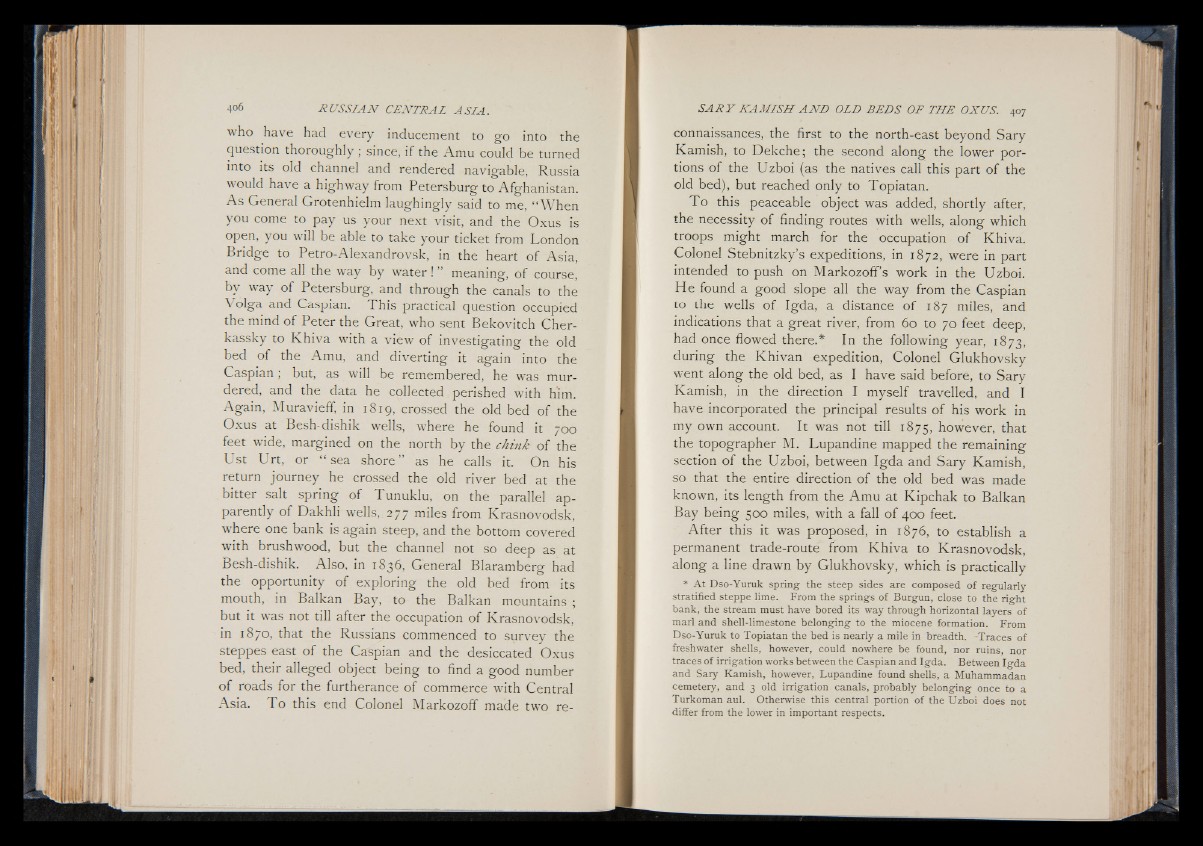
who have had every inducement to go into the
question thoroughly ; since, if the Amu could be turned
into its old channel and rendered navigable, Russia
would have a highway from Petersburg to Afghanistan.
A s General Grotenhielm laughingly said to me, “When
you come to pay us your next visit, and the Oxus is
open, you will be able to take your ticket from London
Bridge to Petro-Alexandrovsk, in the heart of Asia,
and come all the way by water ! ” meaning, of course,
by way of Petersburg, and through the canals to the
Volga and Caspian. This practical question occupied
the mind o f Peter the Great, who sent Bekovitch Cherkassky
to Khiva with a view of investigating the old
bed of the Amu, and diverting it again into the
Caspian ; but, as will be remembered, he was murdered,
and the data he collected perished with him.
Again, Muravieff, in 1819, crossed the old bed of the
Oxus at Besh-dishik wells, where he found it 700
feet wide, margined on the north by the chink of the
Ust Urt, or “ sea shore” as he calls it. On his
return journey he crossed the old river bed at the
bitter salt spring of Tunuklu, on the parallel apparently
of Dakhli wells, 277 miles from Krasnovodsk,
where one bank is again steep, and the bottom covered
with brushwood, but the channel not so deep as at
Besh-dishik. Also, in 1836, General Blaramberg had
the opportunity o f exploring the old bed from its
mouth, in Balkan Bay, to the Balkan mountains ;
but it was not till after the occupation of Krasnovodsk,
in 1870, that the Russians commenced to survey the
steppes east o f the Caspian and the desiccated Oxus
bed, their alleged object being to find a good number
o f roads for the furtherance o f commerce with Central
Asia. T o this end Colonel Markozoff made two reconnaissances,
the first to the north-east beyond Sary
Kamish, to Dekche; the second along the lower portions
of the Uzboi (as the natives call this part of the
old bed), but reached only to Topiatan.
T o this peaceable object was added, shortly after,
the necessity of finding routes with wells, along which
troops might march for the occupation of Khiva.
Colonel Stebnitzky’s expeditions, in 1872, were in part
intended to push on Markozoff’s work in the Uzboi.
He found a good slope all the way from the Caspian
to the wells o f Igda, a distance o f 187 miles, and
indications that a great river, from 60 to 70 feet deep,
had once flowed there.* In the following year, 1873,
during the Khivan expedition, Colonel Glukhovsky
went along the old bed, as I have said before, to Sary
Kamish, in the direction I myself travelled, and I
have incorporated the principal results of his work in
my own account. It was not till 1875, however, that
the topographer M. Lupandine mapped the remaining
section o f the Uzboi, between Igda and Sary Kamish,
so that the entire direction of the old bed was made
known, its length from the Amu at Kipchak to Balkan
Bay being 500 miles, with a fall of 400 feet.
After this it was proposed, in 1876, to establish a
permanent trade-route from Khiva to Krasnovodsk,
along a line drawn by Glukhovsky, which is practically
* At Dso-Yuruk spring- the steep sides are composed of regularly
stratified steppe lime. From the springs of Burgun, close to the right
bank, the stream must have bored its way through horizontal layers of
marl and shell-limestone belonging to the miocene formation. From
Dso-Yuruk to Topiatan the bed is nearly a mile in breadth. -Traces of
freshwater shells, however, could nowhere be found, nor ruins, nor
traces of irrigation works between the Caspian and Igda. Between Igda
and Sary Kamish, however, Lupandine found shells, a Muhammadan
cemetery, and 3 old irrigation canals, probably belonging once to a
Turkoman aul. Otherwise this central portion of the Uzboi does not
differ from the lower in important respects.